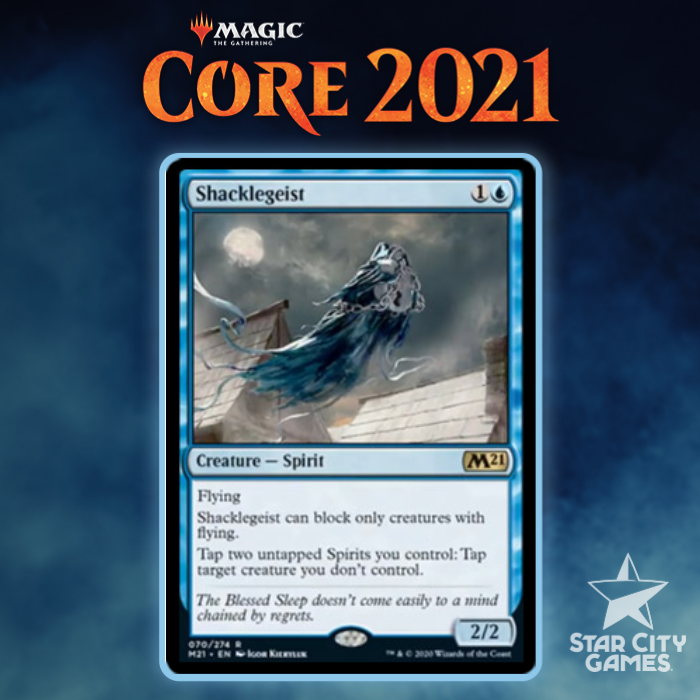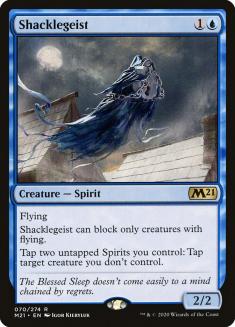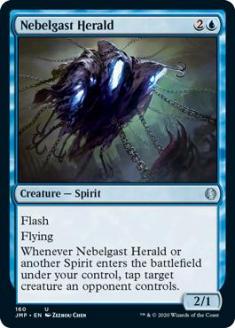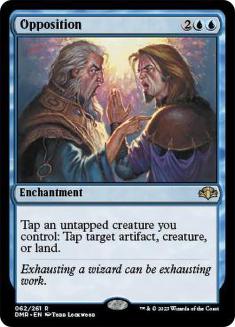The card I’m discussing today fits very easily into multiple archetypes in older formats. Both Pioneer and Modern can use this puppy, and it can completely change the texture of games where it’s involved. What might that thing be?
Spirits have been a big part of Pioneer since its inception last year. There has been much debate on which color combination is better: Azorius or Bant. Now that we have Shacklegeist, I think that debate might finally be settled once and for all.
I want to stress just how good I think this card is. Anyone who’s played with Spirits before understands how mediocre they are at defense. Supreme Phantom has a nice butt to make blocking against Mono-Red Aggro a bit more palatable, but most Spirits are low on toughness by design. Because of that, it usually becomes a race in the air while trying to interact lightly with creatures on the ground.
The addition of Nebelgast Herald helped make racing much easier. Tapping down one or two creatures per combat while just casting your spells gave you a huge advantage against other creature-based decks. If your opponents don’t kill Nebelgast Herald, there’s a low chance they’ll be able to race. Shacklegeist takes that one step further.
Before we continue, I wanted to give y’all a brief history lesson.
Being able to immediately tap an opposing permanent, even when that permanent has summoning sickness, adds significant value to your creatures. Shacklegeist can’t tap lands like Opposition can, but tapping your opponent’s creatures with freshly cast Spirits is a big deal.
While Opposition itself was mostly used to tap opponents’ lands, there was a lot of play inside the combat step to keep you alive. Shacklegeist will cost more creatures to get the job done, but managing the combat situation will entirely rely on how you navigate it. Sometimes it might be worth getting in two damage while you’re taking three or more. But Shacklegeist gives you complete control over how those attacks will go.
Anyone who’s ever played Limited knows just how busted this type of effect can be. But it’s not just a great Limited mechanic. Understanding Limited is a great way to understand just how good Shacklegeist really is. Assuming there was a potential “Spirit Clan” draft archetype, the entire world would quickly learn how messed up Shacklegeist could be. Since it’s kind of a standalone in the set, Shacklegeist probably won’t get much press until the Spirit ringers on Magic Online (MTGO) get their hands on it.
I only bring up Opposition because of the immediacy. Getting value out of your creatures the turn you cast them is all you can ask. The fact that Shacklegeist is a two-mana creature that can attack and block is incredible. It also partially fuels itself, which means you can pair it with a one-drop creature to start preventing damage and containing your opponent’s aggression.
Tradewinde Rider is another card similar to Shacklegeist, though perhaps a bit more powerful because it can bounce lands! It is half the casting cost, after all. While I don’t think Tradewind Rider would see much play in today’s economy, an effect similar to that is always worth a second look.
Shacklegeist can be used immediately. It has a desirable creature type that gets pumped by efficient lords. Spirits as a tribe have been incredibly consistent in Pioneer, and often show up in Modern whenever things settle down a little. This creature fundamentally changes the deck and I believe is an automatic four-of inclusion. It dominates any creature-based matchup. It’s out of control. Now, listen as I make one of the biggest called shots in my life:
When the dust settles, Shacklegeist will go down as one of the best creatures in Pioneer.
Azorius VS Bant
One important aspect of Shacklegeist is that it requires additional bodies to work. While the manabase in Azorius is quite good, and access to Mutavault is a big deal, I can’t imagine playing Azorius Spirits with Shacklegeist when you can play Collected Company.
When playing Spirits in the past, the Collected Company debate is rather lively. Many purists prefer the “Flash” nature of Azorius, where those who like more raw power per capita prefer Bant and Collected Company. The two decks play the game in a similar fashion, but one is much stronger against interactive strategies. The card Collected Company completely changes the dynamic of a game, but the cost is sometimes you draw Collected Company and can’t cast it because of the restrictive mana cost. Both four mana and requiring green mana really mess with your curve, and punish you for playing manabases including Botanical Sanctum.
But Shacklegeist just needs bodies, and the easiest way to generate bodies in Spirits is to cast cards that generate more than one. I’m likely going to experiment with the two archetypes once Shacklegeist hits the shelves to see which one I like better, but theory dictates that Collected Company should be better. However, there’s always the chance playing the likes of Hanged Executioner and just having a healthier manabase means your Shacklegeist is more reliable. It seems like the games you lose with Spirits are the games where you get stuck on two mana or are missing a color. I don’t know how to solve that issue without access to more reliable multicolor lands.
People often dismiss the importance of a simple manabase. Draws that miss a color for more than a turn or two are often too weak to catch back up, even when you immediately draw the missing color. If you’re stuck without a color for too long, that color of spell starts to build up in your hand, and drawing one colored source of that missing color (usually white) isn’t enough to get you back into the game. Spirits just aren’t good enough at making a comeback, as their strength draws from synergy rather than having raw individual power.
Formats featuring a power level as high as Pioneer don’t allow forgiveness for stumbling. That alone might be reason enough to play Azorius over Bant. Let’s take a look at both versions and discuss their strengths and weaknesses, as well as how Shacklegeist fits into the overarching strategy.
Creatures (32)
- 4 Rattlechains
- 4 Spell Queller
- 3 Selfless Spirit
- 4 Mausoleum Wanderer
- 2 Nebelgast Herald
- 4 Supreme Phantom
- 4 Empyrean Eagle
- 3 Spectral Sailor
- 4 Shacklegeist
Lands (24)
Spells (4)

The “stock” version of virtually every Bant version of Spirits just maxes out on all four copies of the spells listed above. Cutting a Spectral Sailor, Selfless Spirit, and two Nebelgast Herald to fit in Shacklegeist isn’t exactly revolutionary, but it’s hard to argue changing much else. It might be that Shacklegeist straight up replaces Nebelgast Herald, but I’m confident that you can play both without it cause too much harm to your overall strategy. These Spirits that are good against creatures as opposed to good against noncreature spells are just fine at attacking and blocking when their defensive abilities are not needed.
The green addition to the deck for Collected Company comes with a small amount of problems that we discussed above, but my instincts tell me pairing Shacklegeist with the powerful instant is important to functionality. Raw body count matters when it comes to Shacklegeist and your other Spirit lords. With that in mind, it might be worth just cutting Nebelgast Herald entirely to keep the mana cost of your creatures a bit lower.
Shacklegeist acting as another two-mana creature for the deck is also somewhat of a nice pickup. Most of the time, all you need to do is make sure you play something in the first two turns so that your opponent is forced to run head-first into Spell Queller. The hard games of Spirits come when you draw too many expensive threats and you find a turn or two where you’re bottlenecked on casting more than a single spell in a given turn.
Shacklegeist also allows you to do something that Spirits doesn’t often do: tap out on their own turn. You’re incentivized to cast more creatures before your opponent’s attack phase so you can tap them down. Tapping out on your own turn used to make things difficult, but now you have a good reason to do so. That means Mausoleum Wanderer will be better. That means casting Empyrean Eagle on curve is A-OK. You’re allowed to be much more aggressive in the early turns because it means you can dominate how combat works.
I’ll be toying with the numbers a bit, and probably trying out Hanged Executioner or other Spirits at some point, but the point of the matter is this: Collected Company is lit when it works. Shacklegeist is just a freebie for the archetype that just so happens to work perfectly with all the rest of the cards.
Creatures (34)
- 4 Rattlechains
- 4 Spell Queller
- 4 Selfless Spirit
- 4 Mausoleum Wanderer
- 4 Supreme Phantom
- 4 Empyrean Eagle
- 4 Spectral Sailor
- 2 Brazen Borrower
- 4 Shacklegeist
Lands (23)
Spells (3)

While you lose Collected Company here, the curve looks beautiful. You get access to a few more interactive tools like Brazen Borrower, as well as some spell-based interaction like Mystical Dispute. While Mystical Dispute isn’t exactly efficient against nonblue decks, it acts like a hard counter on the third turn if you have the time for it. The biggest thing to remember is how prevalent blue cards are in Pioneer, and how often Mystical Dispute will just put your opponent in the dumpster.
While I don’t know if two, three, or four copies of Mutavault is correct, I feel like trying the full amount at some point might be necessary. I actively hate Port Town, but there is merit in trying hard to turn it on and make it a good multicolor land. That means playing a few more basic lands than normal and staying away from stuff like Unclaimed Territory. We can only use the lands we have access to, after all. If we end up cutting Teferi and Brazen Borrower and most non-Spirit spells, including those in our sideboard, maxing out on Unclaimed Territory might be really nice.
If you’re a fan of Spirits in any format, I highly recommend picking up a set of Shacklegeist. I think it will fundamentally change how the deck interacts with other creature decks. It’s an efficient, powerful tool that can be used immediately. It’s a nightmare for the mirror and will even tap down mana creatures from the opponent when you need them to. The play patterns that this card promises are extremely one-sided in your favor and offer some creative situations for walking your opponent into combat tricks.
I’m very glad that Shacklegeist exists.






